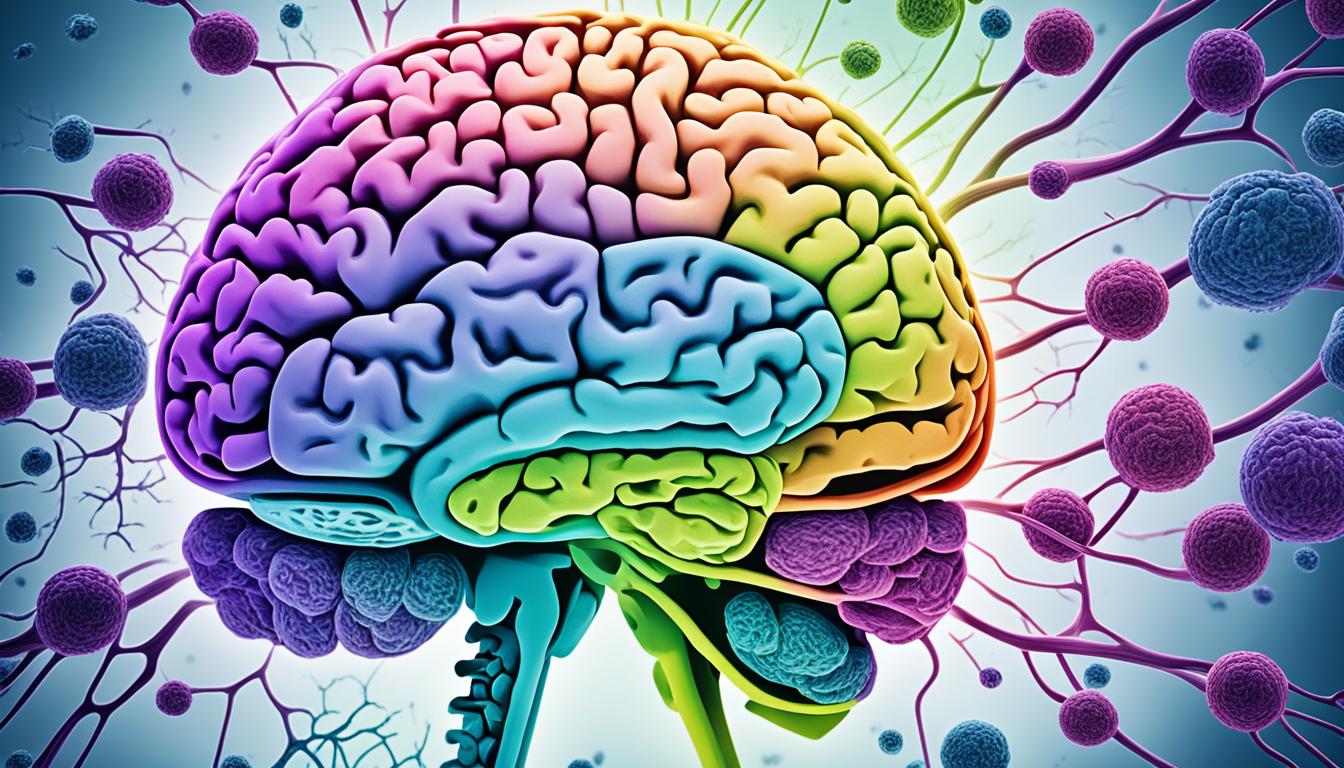Craniopharyngioma is a non-cancerous brain tumor. It grows from leftover cells from when you were just an embryo. The tumor sits at the base of your brain and can affect both kids and adults.
It’s rare, with about 1.3 new cases per million people each year. This growth can press on some very important parts of your brain. These include the pituitary gland, the hypothalamus, and the optic chiasm. This can cause many different symptoms.
Some common signs of craniopharyngioma are trouble seeing, problems with your hormones, and issues with how your brain works. You might have a hard time seeing things clearly or lose parts of your vision. This happens because the tumor puts pressure on your optic nerves.
The tumor can also mess with your hormones, leading to issues like gaining weight or getting diabetes insipidus. This happens when your brain can’t manage how much water your body gets rid of.
To find out if you have craniopharyngioma, doctors will look at your medical history, check you over, and probably run some scans. They might also test your hormone levels. It’s very important to diagnose this tumor early to start the best treatment.
The main ways to treat craniopharyngioma are through surgery, radiation, and fixing any hormone problems. Surgery is done to take as much of the tumor out as possible. Doctors are careful to not hurt the important parts around it.
After surgery, you might need radiation to kill any tumor cells left. And because the tumor or its treatment can mess with your hormones, you might need medicine to balance them out.
Key Takeaways:
- Craniopharyngioma is a benign tumor that affects both children and adults.
- It can compress important anatomical structures, leading to various symptoms including visual disturbances and hormonal imbalances.
- Diagnosis involves medical history evaluation, physical examination, imaging studies, and hormone level testing.
- Treatment options include surgical resection, radiation therapy, and hormone replacement therapy.
- Stem cell therapy represents a promising approach for the future treatment of craniopharyngioma.
Types and Subdivisions of Craniopharyngioma
Craniopharyngiomas are benign brain tumors. They are classified into specific types based on their origin. This classification helps in accurate diagnosis and treatment. The two main types are adamantinomatous and papillary.
Adamantinomatous Craniopharyngioma
Adamantinomatous craniopharyngiomas are found more in children. They are thought to come from a duct in the brain. These tumors can have solid or fluid parts and often have calcifications.
Papillary Craniopharyngioma
Papillary craniopharyngiomas are rare and usually found in adults. They start from the front of the pituitary gland. These tumors usually appear well-defined and can be solid or fluid-filled. They tend not to have calcifications.
The other two kinds of craniopharyngioma are Rathke’s pouch tumor and craniopharyngeal duct tumor.
| Type | Age Group | Origin | Characteristics |
|---|---|---|---|
| Adamantinomatous Craniopharyngioma | Children | Craniopharyngeal Duct cells | Solid or cystic with calcifications |
| Papillary Craniopharyngioma | Adults | Pituitary Gland cells | Well-circumscribed, solid or cystic, typically non-calcified |
| Rathke’s Pouch Tumor | Varies | Rathke’s Pouch cells | Involves the remnants of Rathke’s pouch |
| Craniopharyngeal Duct Tumor | Varies | Craniopharyngeal Duct cells | Arises from the craniopharyngeal duct |
Clinical Manifestations and Complications of Craniopharyngioma
Craniopharyngioma is a benign tumor that starts from early tissue near the sella turcica. It leads to different symptoms and serious issues. What someone feels is tied to where the tumor is and how big it has become.
Common Symptoms
Problems with eyesight are common because the tumor can press on optic nerves. This can cause parts of the vision to be missing. The pituitary gland may not work right, leading to things like putting on too much weight or having diabetes insipidus.
Headaches are a big issue because of the tumor’s impact on the brain. They can be severe and come often, making life hard for those affected.
Visual Disturbances
When optic nerves are compressed, it affects sight. People might have trouble with seeing things clearly or lose parts of their vision. It’s very important to treat these visual issues quickly to keep the eyesight from getting worse.
Hydrocephalus and Foramen of Monro Occlusion
Hydrocephalus happens when the tumor blocks the foramen of Monro. It makes fluid build up, causing pressure inside the head. This can lead to a larger head in babies, headaches, and feeling sick.
Treatment-Associated Complications
Removing the tumor through surgery aims to ease symptoms. But this can sometimes cause problems by harming nearby areas. Surgical treatment may create its own set of issues.
Radiation therapy aims to stop the tumor from growing back. Yet, it might cause some memory and thinking problems. It can also hurt the blood vessels near the tumor.
Handling craniopharyngioma’s problems means working with many experts. Regular visits and a team approach can help deal with treatment and aftercare. This way, the chances for a good recovery increase.
Conclusion
Craniopharyngioma is not easy to treat. It needs a plan that looks at all sides to get the best results. Doctors might choose surgery, radiation, or give hormones to help.
Now, there’s a new hope in stem cell therapy. This shines a light on the future of how we might treat craniopharyngioma. It could offer new chances for a better outcome.
The outlook for patients depends on many things. This includes how much of the tumor they could take out, any problems after surgery, and how well they respond to treatment.
Keeping in touch with a team of doctors and specialists is really important. They make sure to catch and treat any issues that come up. This can help patients live better and longer lives.
In the end, craniopharyngioma poses its own set of problems. Yet, with current treatments and new advances like stem cell therapy, there’s hope. Healthcare workers are working hard to better how they care for those with this disease.

